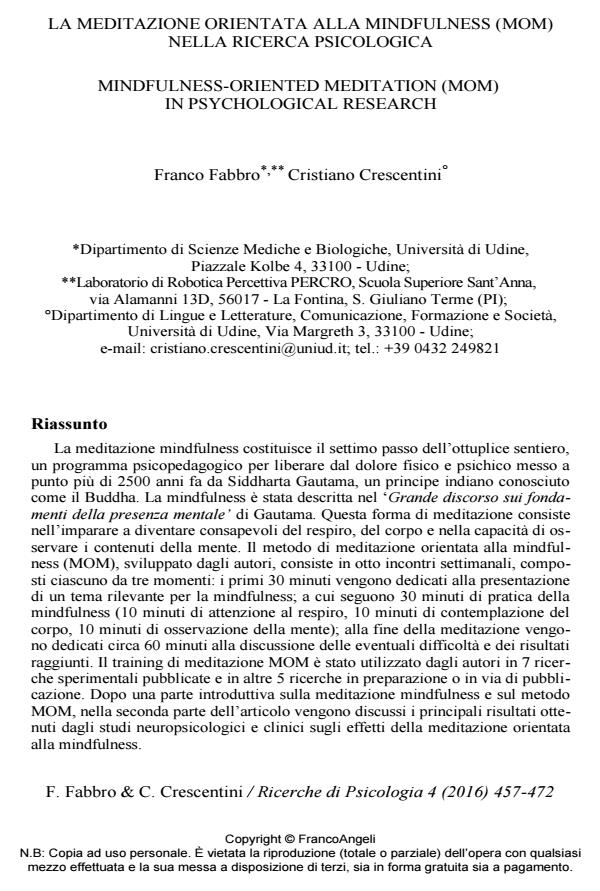Mindfulness-oriented meditation (mom) in psychological research
Journal title RICERCHE DI PSICOLOGIA
Author/s Franco Fabbro, Cristiano Crescentini
Publishing Year 2017 Issue 2016/4
Language Italian Pages 16 P. 457-472 File size 195 KB
DOI 10.3280/RIP2016-004001
DOI is like a bar code for intellectual property: to have more infomation
click here
Below, you can see the article first page
If you want to buy this article in PDF format, you can do it, following the instructions to buy download credits

FrancoAngeli is member of Publishers International Linking Association, Inc (PILA), a not-for-profit association which run the CrossRef service enabling links to and from online scholarly content.
Mindfulness meditation is the seventh step of the Noble Eightfold Path, a psycho-educational program for liberation from physical and psychic pain and suffering developed over 2,500 years ago by Siddhartha Gautama, an Indian prince known as the Buddha. Mindfulness has been described in "The Great Discourse on the Foundations of Mindfulness" of Gautama. This form of meditation consists of learning to become aware of the breath, the body and the ability to observe the contents of the mind. The method of mindfulness-oriented meditation (MOM) developed by the authors consists of eight weekly sessions, each involving three parts: the first 30 minutes are devoted to the presentation of a relevant issue for mindfulness; the middle 30 minutes concerns the practice of mindfulness (10 minutes of attention to the breath, 10 minutes of contemplation of the body, 10 minutes of observation of the mind); at the end of the meditation about 60 minutes are dedicated to the discussion of any difficulties and achievements. The MOM training has been employed by the authors in 7 published experimental researches and in 5 other studies currently in progress. After an introductory session on mindfulness meditation and on the MOM method, in the second part of the article we will discuss the main results obtained from the neuropsychological and clinical studies on the effects of mindfulness-oriented meditation.
Keywords: Meditation, mindfulness, neuropsychology, psychopathology
- Universal crisis psychoeducational interventions in schools: A scoping review Michele Capurso, Simona De Stasio, Benedetta Ragni, in School Psychology International /2022 pp.339
DOI: 10.1177/01430343221104986 - Effects of Mind-Body Interventions on Adolescents’ Cooperativeness and Emotional Symptoms Susanna Feruglio, Stefania Pascut, Alessio Matiz, Andrea Paschetto, Cristiano Crescentini, in Behavioral Sciences /2022 pp.33
DOI: 10.3390/bs12020033 - Temperament and Character Moderate the Effects of Mindfulness Training on Psychological and Professional Well-Being of School Teachers Alessio Matiz, Stefania Pascut, Franco Fabbro, Cristiano Crescentini, in Mindfulness /2025 pp.1376
DOI: 10.1007/s12671-025-02573-0 - Positive Impact of Mindfulness Meditation on Mental Health of Female Teachers during the COVID-19 Outbreak in Italy Alessio Matiz, Franco Fabbro, Andrea Paschetto, Damiano Cantone, Anselmo Roberto Paolone, Cristiano Crescentini, in International Journal of Environmental Research and Public Health /2020 pp.6450
DOI: 10.3390/ijerph17186450
Franco Fabbro, Cristiano Crescentini, La meditazione orientata alla mindfulness (mom) nella ricerca psicologica in "RICERCHE DI PSICOLOGIA " 4/2016, pp 457-472, DOI: 10.3280/RIP2016-004001